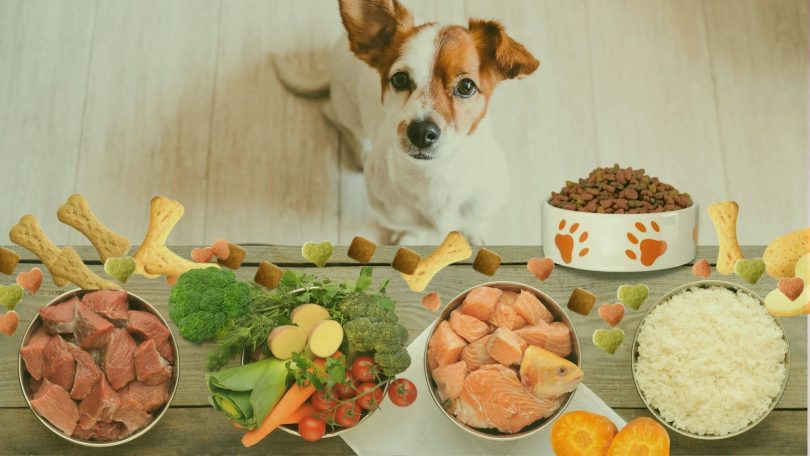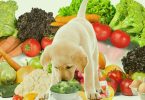Looking for the best home made natural dog food recipes? Look no further! From nutritious to delicious, we’ve got you covered.
Many raw and fresh food feeders believe that you should never combine dry dog food with raw dog food. We could understand why dry takes longer to digest than raw and how dry affects the pH of the dog’s stomach. But one could also find a slew of, usually, irrational assertions or concerns.
We now know that there quite a few myths to dispel within this space thanks to new information and scientific logic! Unless your dog has a fragile or sick digestive tract, it is OK and acceptable to give your dog dry food and raw food simultaneously. Although many dogs consume both dry and raw with no problems, this myth nevertheless circulates from time to time, confounding novice raeeders and even discouraging them from introducing raw meals.
Although the benefits of naturaldog food are quite organic and valuable, it is not wrong or harmful to provide your dog with dry food. Here is what you need to know about the fundamentals of natural dog food and how raw food can be a part of the process.
Benefits of natural dog food
Here are a few of the benefits of raw dog food. The benefits of raw dog food are many.
-Improved oral health
-Skin and coat that is more lustrous
-Digestion enhancement
-Enhanced food pleasure
-Increased stamina and energy
-Stools that are fewer and better shaped
-Immune system boosted
-Fewer allergies
There are many types of organic food for dogs that you might find feed to them at any time of the day. But there are a couple of critical points to remember here when it comes to raw dog food. It is essential to know whether your dog’s digestive system is healthy enough to tackle it. And if not, then you opt for dry food. This is fine because it has its benefits with all the nutrients you need for your dog.
Benefits of dry food
Because of the high energy level, dog owners only need to use tiny amounts of dry food to fulfill their dog’s demands and keep them satisfied. As a result, dry food is the less expensive alternative.
Proponents also emphasize that buying in smaller amounts is a more ecologically responsible option because it requires less packaging.
Another advantage of dry food is that it is clean and handy. It doesn’t have mushy spills, and if a small amount gets outside the meal bowl, it’s simple to sweep or vacuum it up. Furthermore, odorless dry food is easier to transport on vacation because dogs only require lesser quantities, and it is easy to stock up on ahead of time.
The myths you might hear about raw dog food and dry dog food
Dry food raises the pH of our dog’s stomach, making meat and bones, which is the natural food for dogs, more challenging to digest and killing harmful germs.
We know that a dog’s stomach is considerably more acidic (low pH around 2) than a human’s. That’s why they’re the greatest at dissolving raw meat. Now, the concern was that eating dry might cause the stomach to become less acidic (raised to 4 or 5).
However, gastric pH, or the pH level in the tummy, does not remain constant! When dogs anticipate food, the digestive process commences, and their stomach becomes highly acidic, creating an ideal environment for enzymes like pepsin and lipase to break down nutrients.
Dry or processed foods digest more slowly (10 hours) than fresh whole foods or raw foods (2 hours).
This claim is also illogical from a scientific viewpoint. Different types of food digest differently in other species. When we consume a burger, we break down the bun, meat, and lettuce in various ways.
Now that we are clear that there is no harm in both raw food and dry food, the final question arises: Can you mix raw and dry dog food?
And the answer is quite simple, that is yes! But obviously, we need reasons to justify our answers, so here we begin:
Can you mix raw and dry dog food?
You may combine dry with raw for a week or so to reduce stomach discomfort while feeding your pet raw. Beyond the effects of the dry, mixing raw and dry does no damage, either short-term or long-term. To make ends meet, you might extend the raw meals by adding some dry. Without the need for dry, little thrifty shopping may provide extremely healthy raw, fresh meals for your pet.
The amount of nutrients that can be absorbed is affected by the rate at which food moves through the gut. Your digestive system would be OK if you ate the finest salad ever made with the finest products and a Big Mac at the very same period.
A recent investigation looked at how quickly raw and dry were digested. It was discovered that raw digestion was slower than dry digestion, whereas dry digestion was faster than raw digestion. This is due to the digestive tract releasing extra ‘juices’ as food enters the stomach. Dry comprises carbs, which break down more quickly than protein and fat. The study also discovered that dry had more bile acid than raw, although this did not create any issues.
Mixing raw and dry has been done for years, but it appears that the practice of avoiding this form of feeding has only lately gained popularity. According to rcent studies, combining some fresh, raw food with dry food is far healthier than dry alone. A complete raw natural dog food diet is the finest thing you can give your pet and should be the ideal we all aim for as responsible pet owners.
In a word, all of the hazards that your dog confronts while consuming raw foods and carbohydrates are caused by pH fluctuations. If you can regulate the pH, you will be able to convert your dog to raw food without causing diarrhea, vomiting, or blockage.
And if you offer him both types of meals, he will be less likely to get sick from germs or have an undigested bone trapped in his digestive tract. It will also help him obtain more nourishment from his meals while avoiding the inflammatory and immunological reactions that can occur when foods are not digested.
Given the enormous number of possible benefits of feeding just a 100% raw diet, we would advise limiting dry foods to a bare minimum. However, if it is challenging to execute, or if your budget does not allow for 100% raw, you may utilize this middle ground method. It’s not the perfect method, but it does begin to uncover some of the great benefits that are out there.
A mixture will work well for most dogs, and that is all that matters in the end. You should, however, keep a tight watch on the number of carbohydrates supplied using this approach. This is since many pet owners ‘add raw’ on top of their regular dry. As a result, they are increasing the amount of feed, which may result in overfeeding. Some pet owners have also observed that when they add a raw topper to their dog’s diet, their natural tendency is to quit eating the dry.







